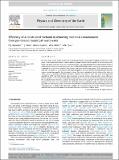| dc.description.abstract | In most capital towns, urban wastewater discharging into the environment is highly enriched in a wide range of microbial contaminants, thus threatening people’s health and the quality of the receiving basin water and other water for reuse. This study focused on evaluating the efficiency of the removal of faecal coliform indicator bacteria and Salmonella spp. by Moshi Municipal urban wastewater treatment system composed of a constructed wetland (CW) system and waste stabilization ponds (WSP) operating in parallel. The CW system is a sub-surface flow type designed in the year 2002 for treating effluent from the second maturation pond of the treatment system. The study considered faecal coliform data taken in 2009 and 2012, and both Salmonella and faecal coliform data taken in 2013 and 2014. Data generated monthly in 2009 and 2012 showed high variations in faecal coliform removal with a mean efficiency of less than 60%. The levels of faecal coliform from both the CW and the last maturation pond were below the acceptable limit. However, a similar investigation done in 2013 and 2014 on the removal of specific pathogen, Salmonella spp., showed that the CW is discharging significantly higher amount of Salmonella spp. than the maturation system. The treated wastewater is currently used for paddy farming, in this way exposing people to health risks. The results highlight the necessity for improving the system monitoring and also the management taking into consideration the end users of effluent water. | en_US |

